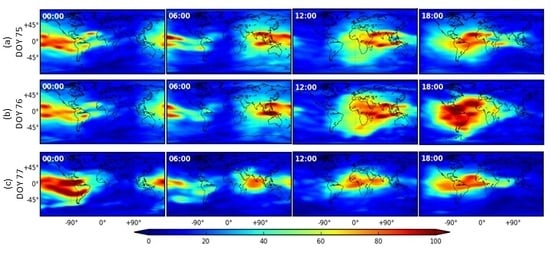Adaptive Modeling of the Global Ionosphere Vertical Total Electron Content
Abstract
1. Introduction
2. Global VTEC Representation Based On B-Splines
Coordinate System
3. GNSS Ionospheric Observables
- Observations with an elevation angle of less than 10 were rejected from the data to avoid contributions from likely very noisy measurements.
- To mitigate the errors due to multi-path effects on pseudo-range measurements, which are generally inversely proportional to the satellite elevation angle, only the observations with elevation angles larger than 20 are included in the determination of the leveling bias (3).
- Moreover, an elevation dependent weighting function, e.g., , is introduced to leverage the influence of more precise observations. means the elevation angle of the observation along the arc.
- A pre-processing algorithm was developed for the recursive processing of GNSS data acquired as hourly data blocks broadcasted, e.g., by the IGS global data centers. To reach a maximum number of observations and a high pre-processing quality, data blocks with a moving window of 3 h length are considered. For instance, to apply the pre-processing procedures to a new acquired data set between and , a data set with a window length of 3 h extending from to is considered for a more accurate computation of the leveling bias.
4. Adaptive Estimation of Global Ionospheric VTEC
4.1. Model Definition
4.2. Measurement Model
4.3. Prediction Model
4.4. Adaptive Filtering Using Method of Variance-Components (VC) Estimation
4.5. Constrained Filtering
5. Results and Discussions
5.1. Filter Settings
5.2. Validation Methods and Data Sets
5.3. Comparisons to IGS and IAACs
5.3.1. dSTEC Analysis
5.3.2. Altimetry Comparisons
5.4. Evaluation of the Proposed Approach
6. Conclusions
Author Contributions
Funding
Acknowledgments
Conflicts of Interest
References
- Kalman, R. A new approach to linear filtering and prediction problems. J. Basic Eng. 1960, 82, 35–45. [Google Scholar] [CrossRef]
- Evensen, G. The Ensemble Kalman Filter: Theoretical formulation and practical implementation. Ocean Dyn. 2003, 53, 343–367. [Google Scholar] [CrossRef]
- Grewal, M.S.; Andrews, A.P. Kalman Filtering: Theory and Practice Using MATLAB, 2nd ed.; John Wiley & Sons, Inc.: Hoboken, NJ, USA, 2008; p. 416. [Google Scholar]
- Brown, R.G.; Hwang, P.Y.C. Introduction to Random Signals and Applied Kalman Filtering: With MATLAB Exercises, 4th ed.; John Wiley & Sons, Inc.: Hoboken, NJ, USA, 2012. [Google Scholar]
- Erdogan, E.; Schmidt, M.; Seitz, F.; Durmaz, M. Near real-time estimation of ionosphere vertical total electron content from GNSS satellites using B-splines in a Kalman filter. Ann. Geophys. 2017, 35, 263–277. [Google Scholar] [CrossRef]
- Maybeck, P.S. Stochastic Models, Estimation and Control; Academic Press: New York, NY, USA, 1979; Volume I. [Google Scholar]
- Hide, C.; Moore, T.; Smith, M. Adaptive Kalman filtering algorithms for integrating GPS and low cost INS. In PLANS 2004. Position Location and Navigation Symposium (IEEE Cat. No.04CH37556); IEEE: Piscataway, NJ, USA, 2004; pp. 227–233. [Google Scholar] [CrossRef]
- Yang, Y.; Gao, W. An optimal adaptive Kalman filter. J. Geod. 2006, 80, 177–183. [Google Scholar] [CrossRef]
- Hu, C.; Chen, W.; Chen, Y.; Liu, D. Adaptive Kalman Filtering for Vehicle Navigation. J. Glob. Position. Syst. 2003, 2, 42–47. [Google Scholar] [CrossRef]
- Ding, W.; Wang, J.; Rizos, C.; Kinlyside, D. Improving Adaptive Kalman Estimation in GPS/INS Integration. J. Navig. 2007, 60, 517–529. [Google Scholar] [CrossRef]
- Magill, D. Optimal adaptive estimation of sampled stochastic processes. IEEE Trans. Autom. Control 1965, 10, 434–439. [Google Scholar] [CrossRef]
- Mohamed, A.H.; Schwarz, K.P. Adaptive Kalman Filtering for INS/GPS. J. Geod. 1999, 73, 193–203. [Google Scholar] [CrossRef]
- Yang, Y.; Xu, T. An Adaptive Kalman Filter Based on Sage Windowing Weights and Variance Components. J. Navig. 2003, 56, 231–240. [Google Scholar] [CrossRef]
- Helmert, F.R. Die Ausgleichungsrechnung nach der Methode der Kleinsten Quadrate, 3rd Auflage; B.G. Teubner: Leipzig, Germany, 1924. [Google Scholar]
- Crocetto, N.; Gatti, M.; Russo, P. Simplified formulae for the BIQUE estimation of variance components in disjunctive observation groups. J. Geod. 2000, 74, 447–457. [Google Scholar] [CrossRef]
- Yu, Z. A universal formula of maximum likelihood estimation of variance-covariance components. J. Geod. 1996, 70, 233–240. [Google Scholar] [CrossRef]
- Koch, K.R. Parameter Estimation and Hypothesis Testing in Linear Models; Springer: Berlin/Heidelberg, Germany, 1999. [Google Scholar]
- Koch, K.R. Introduction to Bayesian Statistics, 2nd ed.; Springer: Berlin/Heidelberg, Germany, 2007. [Google Scholar] [CrossRef]
- Koch, K.R.; Kusche, J. Regularization of geopotential determination from satellite data by variance components. J. Geod. 2002, 76, 259–268. [Google Scholar] [CrossRef]
- Gao, Z.; Shen, W.; Zhang, H.; Ge, M.; Niu, X. Application of Helmert Variance Component Based Adaptive Kalman Filter in Multi-GNSS PPP/INS Tightly Coupled Integration. Remote Sens. 2016, 8, 553. [Google Scholar] [CrossRef]
- Chang, G.; Xu, T.; Yao, Y.; Wang, Q. Adaptive Kalman filter based on variance component estimation for the prediction of ionospheric delay in aiding the cycle slip repair of GNSS triple-frequency signals. J. Geod. 2018, 92, 1241–1253. [Google Scholar] [CrossRef]
- Yang, X.; Chang, G.; Wang, Q.; Zhang, S.; Mao, Y.; Chen, X. An adaptive Kalman filter based on variance component estimation for a real-time ZTD solution. Acta Geod. Geophys. 2019, 54, 89–121. [Google Scholar] [CrossRef]
- Kusche, J. A Monte-Carlo technique for weight estimation in satellite geodesy. J. Geod. 2003, 76, 641–652. [Google Scholar] [CrossRef]
- Ziqiang, O. Estimation of variance and covariance components. Bull. Géod. 1989, 63, 139–148. [Google Scholar] [CrossRef]
- Förstner, W. Ein Verfahren zur Schätzung von Varianz- und Kovarianz Komponenten. Allg. Vermess.-Nachrichten 1979, 86, 446–453. [Google Scholar]
- Schmidt, M.; Dettmering, D.; Seitz, F. Using B-Spline Expansions for Ionosphere Modeling. In Handbook of Geomathematics; Freeden, W., Nashed, M.Z., Sonar, T., Eds.; Springer: Berlin/Heidelberg, Germany, 2015; pp. 939–983. [Google Scholar] [CrossRef]
- Limberger, M. Ionosphere Modeling from GPS Radio Occultations and Complementary Data Based on B-Splines. Ph.D. Thesis, Technischen Universität München, Munich, Germany, 2015. [Google Scholar]
- Schumaker, L.L.; Traas, C. Fitting scattered data on spherelike surfaces using tensor products of trigonometric and polynomial splines. Numer. Math. 1991, 60, 133–144. [Google Scholar] [CrossRef]
- Lyche, T.; Schumaker, L.L. A Multiresolution Tensor Spline Method for Fitting Functions on the Sphere. SIAM J. Sci. Comput. 2000, 22, 724–746. [Google Scholar] [CrossRef][Green Version]
- Farzaneh, S.; Forootan, E. Reconstructing Regional Ionospheric Electron Density: A Combined Spherical Slepian Function and Empirical Orthogonal Function Approach. Surv. Geophys. 2017, 1–21. [Google Scholar] [CrossRef]
- Schmidt, M.; Dettmering, D.; Mößmer, M.; Wang, Y.; Zhang, J. Comparison of spherical harmonic and B spline models for the vertical total electron content. Radio Sci. 2011, 46, RS0D11. [Google Scholar] [CrossRef]
- Goss, A.; Schmidt, M.; Erdogan, E.; Görres, B.; Seitz, F. High Resolution Vertical Total Electron Content Maps Based on Multi-Scale B-spline Representations. Ann. Geophys. Discuss. 2019, 2019, 1–34. [Google Scholar] [CrossRef]
- Schmidt, M. Towards a Multi-Scale Representation of Multi-Dimensional Signals. In VII Hotine-Marussi Symposium on Mathematical Geodesy, International Association of Geodesy Symposia; Sneeuw, N., Novák, P., Crespi, M., Sansò, F., Eds.; Springer: Berlin/Heidelberg, Germany, 2012; Volume 137, pp. 119–127. [Google Scholar] [CrossRef]
- Schmidt, M. Wavelet modelling in support of IRI. Adv. Space Res. 2007, 39, 932–940. [Google Scholar] [CrossRef]
- Limberger, M.; Liang, W.; Schmidt, M.; Dettmering, D.; Hugentobler, U. Regional representation of F2 Chapman parameters based on electron density profiles. Ann. Geophys. 2013, 31, 2215–2227. [Google Scholar] [CrossRef][Green Version]
- Zeilhofer, C.; Schmidt, M.; Bilitza, D.; Shum, C. Regional 4-D modeling of the ionospheric electron density from satellite data and IRI. Adv. Space Res. 2009, 43, 1669–1675. [Google Scholar] [CrossRef]
- Goss, A.; Schmidt, M.; Erdogan, E.; Seitz, F. Global and Regional High-Resolution VTEC Modelling Using a Two-Step B-Spline Approach. Remote Sens. 2020, 12, 1198. [Google Scholar] [CrossRef]
- Laundal, K.M.; Gjerloev, J.W. What is the appropriate coordinate system for magnetometer data when analyzing ionospheric currents? J. Geophys. Res. A Space Phys. 2014, 119, 8637–8647. [Google Scholar] [CrossRef]
- Mannucci, A.J.; Wilson, B.D.; Yuan, D.N.; Ho, C.H.; Lindqwister, U.J.; Runge, T.F. A global mapping technique for GPS-derived ionospheric total electron content measurements. Radio Sci. 1998, 33, 565–582. [Google Scholar] [CrossRef]
- Gustafsson, G.; Papitashvili, N.; Papitashvili, V. A revised corrected geomagnetic coordinate system for Epochs 1985 and 1990. J. Atmos. Terr. Phys. 1992, 54, 1609–1631. [Google Scholar] [CrossRef]
- Baker, K.B.; Wing, S. A new magnetic coordinate system for conjugate studies at high latitudes. J. Geophys. Res. 1989, 94, 9139. [Google Scholar] [CrossRef]
- Richmond, A.D. Ionospheric Electrodynamics Using Magnetic Apex Coordinates. J. Geomagn. Geoelectr. 1995, 47, 191–212. [Google Scholar] [CrossRef]
- Roble, R.G.; Ridley, E.C.; Richmond, A.D.; Dickinson, R.E. A coupled thermosphere/ionosphere general circulation model. Geophys. Res. Lett. 1988, 15, 1325–1328. [Google Scholar] [CrossRef]
- Richmond, A.D.; Ridley, E.C.; Roble, R.G. A thermosphere/ionosphere general circulation model with coupled electrodynamics. Geophys. Res. Lett. 1992, 19, 601–604. [Google Scholar] [CrossRef]
- Qian, L.; Burns, A.G.; Emery, B.A.; Foster, B.; Lu, G.; Maute, A.; Richmond, A.D.; Roble, R.G.; Solomon, S.C.; Wang, W. The NCAR TIE-GCM. In Modeling the Ionosphere-Thermosphere System; American Geophysical Union (AGU): Washington, DC, USA, 2014; pp. 73–83. [Google Scholar] [CrossRef]
- Rawer, K. Propagation of decameter waves (h.f. band). In Meteorological and Astronomical Influences on Radio Wave Propogation; Landmark, B., Ed.; Pergamon: Oxford, UK, 1963; p. 221. [Google Scholar]
- Azpilicueta, F.; Brunini, C.; Radicella, S.M. Global ionospheric maps from GPS observations using modip latitude. Adv. Space Res. 2006, 38, 2324–2331. [Google Scholar] [CrossRef]
- Komjathy, A.; Langley, R. An assessment of predicted and measured ionospheric total electron content using a regional GPS network. In Proceedings of the 1996 National Technical Meeting of The Institute of Navigation, Santa Monica, CA, USA, 22–24 January 1996; pp. 615–624. [Google Scholar]
- Laundal, K.M.; Richmond, A.D. Magnetic Coordinate Systems. Space Sci. Rev. 2016, 1–33. [Google Scholar] [CrossRef]
- Ciraolo, L.; Azpilicueta, F.; Brunini, C.; Meza, A.; Radicella, S.M. Calibration errors on experimental slant total electron content (TEC) determined with GPS. J. Geod. 2007, 81, 111–120. [Google Scholar] [CrossRef]
- Rovira-Garcia, A.; Juan, J.M.; Sanz, J.; González-Casado, G.; Ibáñez, D. Accuracy of ionospheric models used in GNSS and SBAS: Methodology and analysis. J. Geod. 2016, 90, 229–240. [Google Scholar] [CrossRef]
- Mannucci, A.J.; Wilson, B.D.; Edwards, C.D. A New Method for Monitoring the Earth’s Ionospheric Total Electron Content Using the GPS Global Network. In Proceedings of the 6th International Technical Meeting of the Satellite Division of The Institute of Navigation (ION GPS 1993), Salt Lake City, UT, USA, 22–24 September 1993; pp. 1323–1332. [Google Scholar]
- Blewitt, G. An Automatic Editing Algorithm for GPS data. Geophys. Res. Lett. 1990, 17, 199–202. [Google Scholar] [CrossRef]
- Hofmann-Wellenhof, B.; Lichtenegger, H.; Wasle, E. GNSS—Global Navigation Satellite Systems. GPS, GLONASS, Galileo, and More; Springer: Wien, Austria, 2008; p. 516. [Google Scholar]
- Subirana, J.S.; Zornoza, J.M.J.; Hernandez-Pajares, M. GNSS Data Processing, Volume 1: Fundamentals and Algorithms; ESA Communications: Oakville, ON, Canada, 2013. [Google Scholar]
- Schaer, S. Mapping and Predicting the Earth’s Ionosphere Using the Global Positioning System. Ph.D. Thesis, University of Bern, Bern, Switzerland, 1999. [Google Scholar]
- Dach, R.; Hugentobler, U.; Fridez, P.; Meindl, M. Bernese GPS Software Version 5.0; Astronomical Institute, University of Bern, Staempfli Publications AG: Bern, Switzerland, 2007. [Google Scholar]
- García-Rigo, A.; Roma-Dollase, D.; Hernández-Pajares, M.; Li, Z.; Terkildsen, M.; Olivares, G.; Ghoddousi-Fard, R.; Dettmering, D.; Erdogan, E.; Haralambous, H.; et al. St. Patrick’s Day 2015 geomagnetic storm analysis based on Real Time Ionosphere Monitoring. In Proceedings of the 19th EGU General Assembly, EGU2017, Vienna, Austria, 23–28 April 2017. [Google Scholar]
- Gelb, A. (Ed.) Applied Optimal Estimation; The MIT Press: Cambridge, MA, USA, 1974; p. 382. [Google Scholar]
- Rauch, H.E.; Striebel, C.T.; Tung, F. Maximum likelihood estimates of linear dynamic systems. AIAA J. 1965, 3, 1445–1450. [Google Scholar] [CrossRef]
- Barker, A.; Brown, D.; Martin, W. Bayesian estimation and the Kalman filter. Comput. Math. Appl. 1995, 30, 55–77. [Google Scholar] [CrossRef]
- Jazwinski, A.H. Stochastic Processes and Filtering Theory; Dover Publications, Inc.: Mineola, NY, USA, 2007. [Google Scholar]
- Simon, D. Kalman filtering with state constraints: A survey of linear and nonlinear algorithms. IET Control Theory Appl. 2010, 4, 1303–1318. [Google Scholar] [CrossRef]
- Teixeira, B.O.S. Constrained State Estimation for Linear and Nonlinear Dynamic Systems. Ph.D. Thesis, Federal University of Minas Gerais, Belo Horizonte, Brazil, 2008. [Google Scholar]
- Bähr, H.; Altamimi, Z.; Heck, B. Variance Component Estimation for Combination of Terrestrial Reference Frames; Technical Report; Schriftenreihe des Studiengangs Geodäsie und Geoinformatik, Universität Karlsruhe: Karlsruhe, Germany, 2007. [Google Scholar]
- Hernández-Pajares, M.; Roma-Dollase, D.; Krankowski, A.; García-Rigo, A.; Orús-Pérez, R. Methodology and consistency of slant and vertical assessments for ionospheric electron content models. J. Geod. 2017, 91, 1405–1414. [Google Scholar] [CrossRef]
- Rovira-Garcia, A.; Juan, J.M.; Sanz, J.; Gonzalez-Casado, G. A Worldwide Ionospheric Model for Fast Precise Point Positioning. IEEE Trans. Geosci. Remote Sens. 2015, 53, 4596–4604. [Google Scholar] [CrossRef]
- Brunini, C.; Camilion, E.; Azpilicueta, F. Simulation study of the influence of the ionospheric layer height in the thin layer ionospheric model. J. Geod. 2011, 85, 637–645. [Google Scholar] [CrossRef]
- Orus, R.; Cander, L.R.; Hernandez-Pajares, M. Testing regional vertical total electron content maps over Europe during the 17–21 January 2005 sudden space weather event. Radio Sci. 2007, 42, 1–12. [Google Scholar] [CrossRef]
- Roma-Dollase, D.; Hernández-Pajares, M.; Krankowski, A.; Kotulak, K.; Ghoddousi-Fard, R.; Yuan, Y.; Li, Z.; Zhang, H.; Shi, C.; Wang, C.; et al. Consistency of seven different GNSS global ionospheric mapping techniques during one solar cycle. J. Geod. 2018, 92, 691–706. [Google Scholar] [CrossRef]
- Hernández-Pajares, M.; Juan, J.M.; Sanz, J.; Orus, R.; Garcia-Rigo, A.; Feltens, J.; Komjathy, A.; Schaer, S.C.; Krankowski, A. The IGS VTEC maps: A reliable source of ionospheric information since 1998. J. Geod. 2009, 83, 263–275. [Google Scholar] [CrossRef]

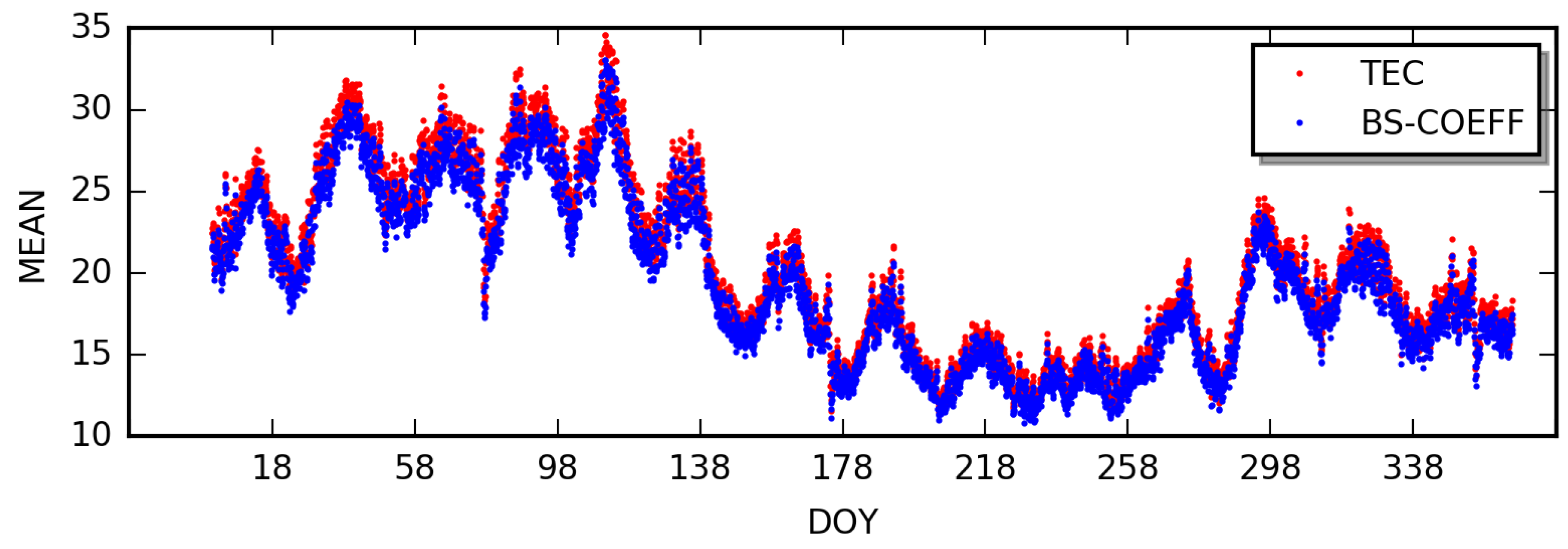


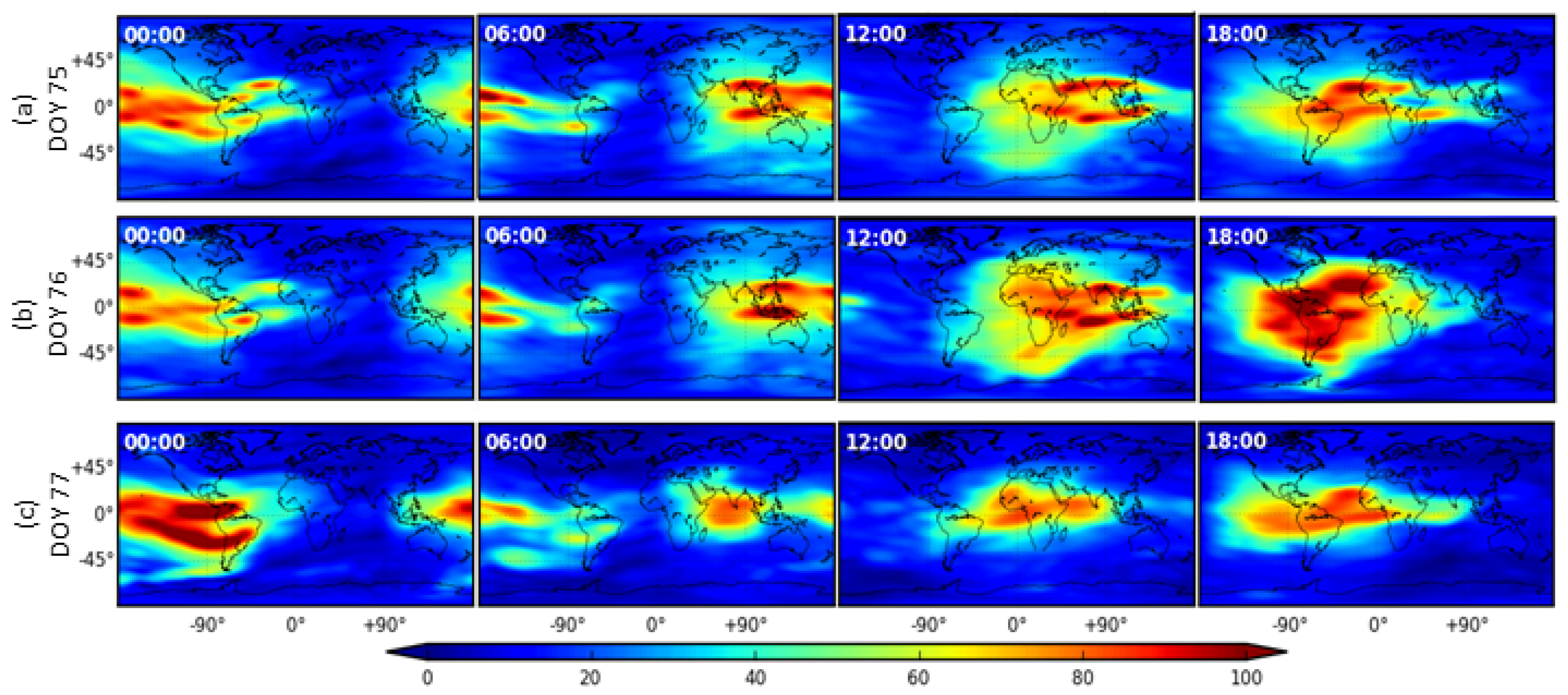
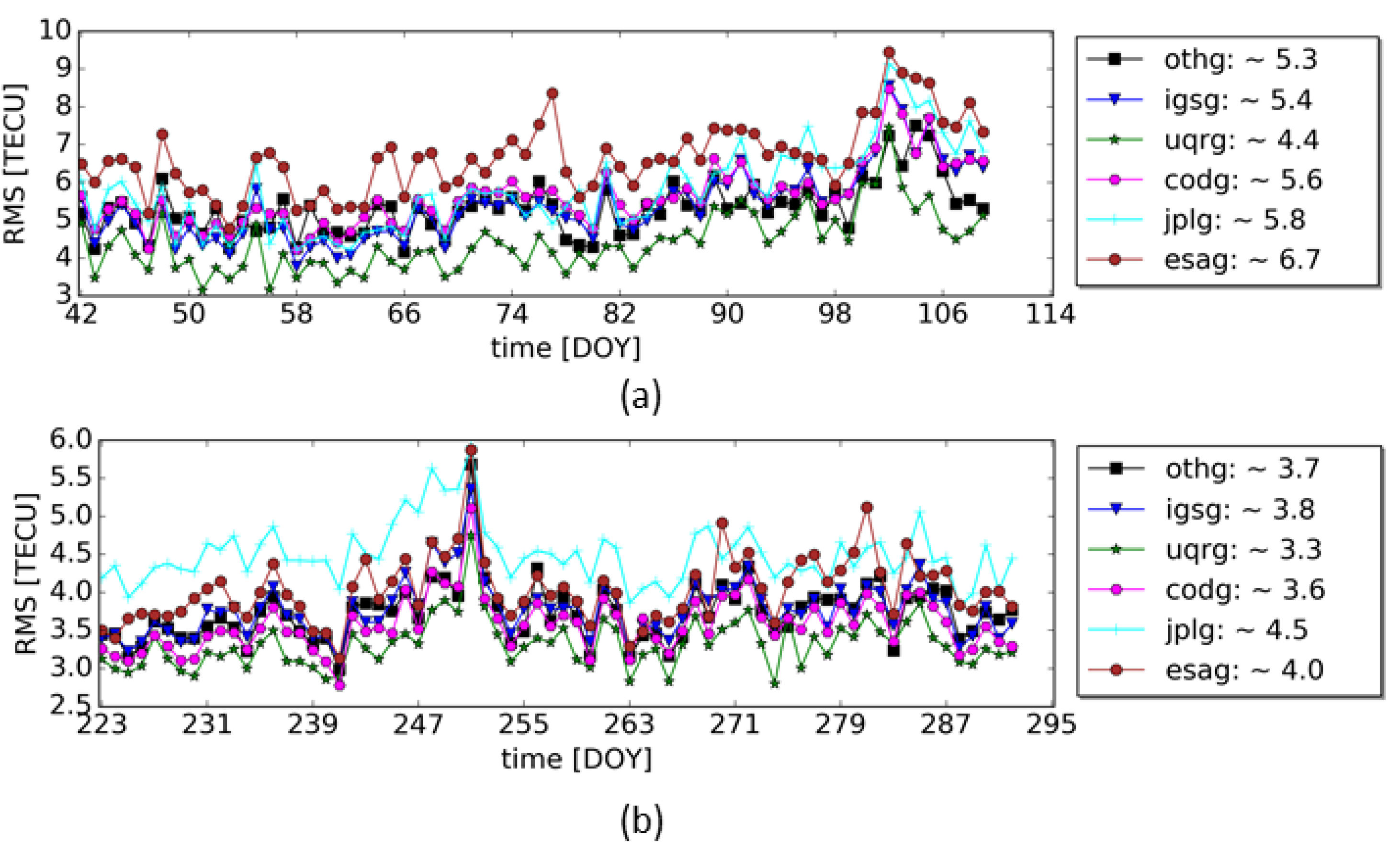
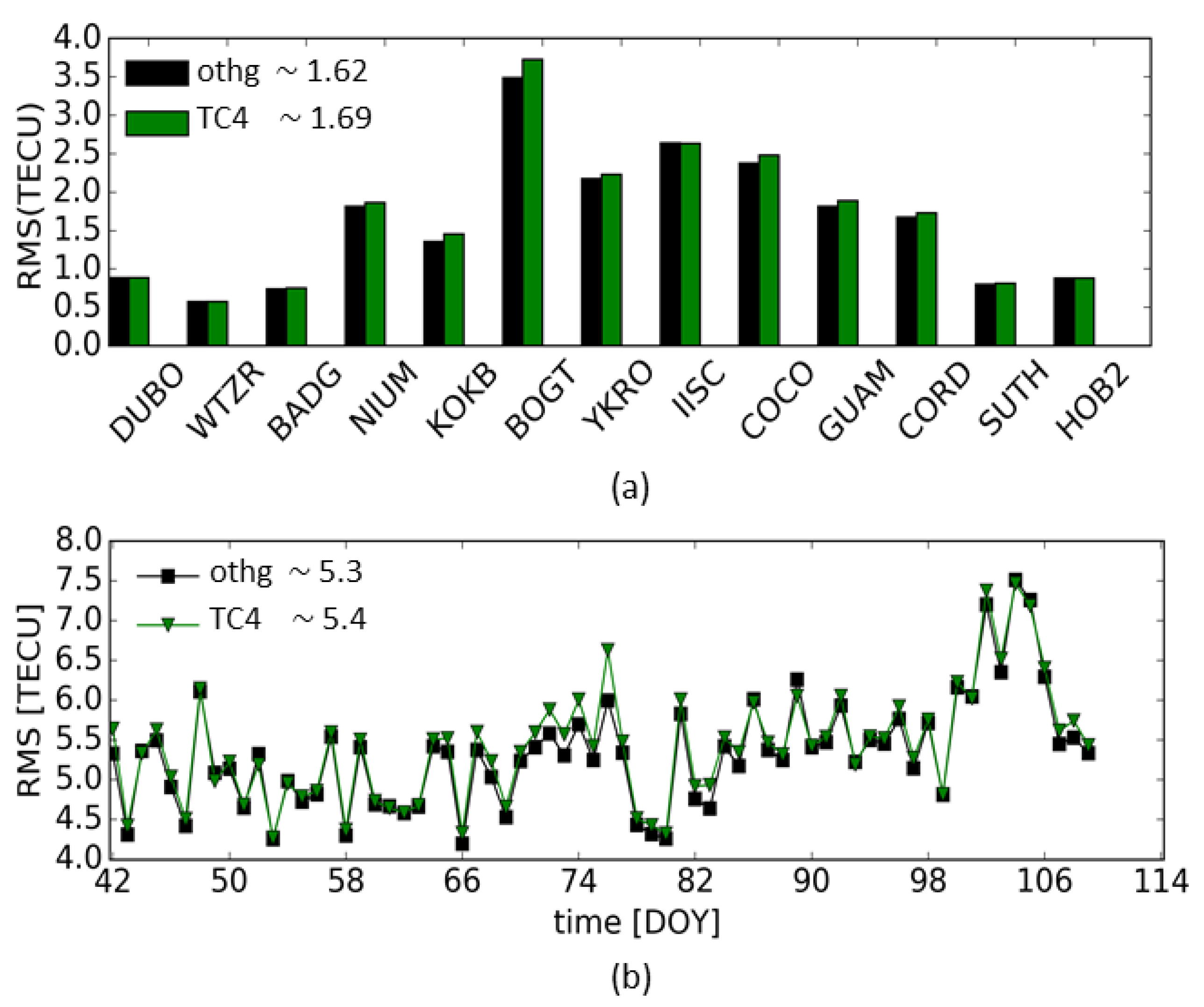
| Product Label | VCE | Process Noise Model | Test Definition | Product Quality (in TECU) |
|---|---|---|---|---|
| othg | Enabled | Enabled | presented approach | , |
| TC1 | Disabled | Disabled | , , | , |
| TC2 | Disabled | Enabled | , , | , |
| TC3 | Disabled | Enabled | , | , |
| TC4 | Enabled | Disabled | , | |
| TC5 | Enabled | Enabled | in Equation (20) | , |
© 2020 by the authors. Licensee MDPI, Basel, Switzerland. This article is an open access article distributed under the terms and conditions of the Creative Commons Attribution (CC BY) license (http://creativecommons.org/licenses/by/4.0/).
Share and Cite
Erdogan, E.; Schmidt, M.; Goss, A.; Görres, B.; Seitz, F. Adaptive Modeling of the Global Ionosphere Vertical Total Electron Content. Remote Sens. 2020, 12, 1822. https://doi.org/10.3390/rs12111822
Erdogan E, Schmidt M, Goss A, Görres B, Seitz F. Adaptive Modeling of the Global Ionosphere Vertical Total Electron Content. Remote Sensing. 2020; 12(11):1822. https://doi.org/10.3390/rs12111822
Chicago/Turabian StyleErdogan, Eren, Michael Schmidt, Andreas Goss, Barbara Görres, and Florian Seitz. 2020. "Adaptive Modeling of the Global Ionosphere Vertical Total Electron Content" Remote Sensing 12, no. 11: 1822. https://doi.org/10.3390/rs12111822
APA StyleErdogan, E., Schmidt, M., Goss, A., Görres, B., & Seitz, F. (2020). Adaptive Modeling of the Global Ionosphere Vertical Total Electron Content. Remote Sensing, 12(11), 1822. https://doi.org/10.3390/rs12111822






